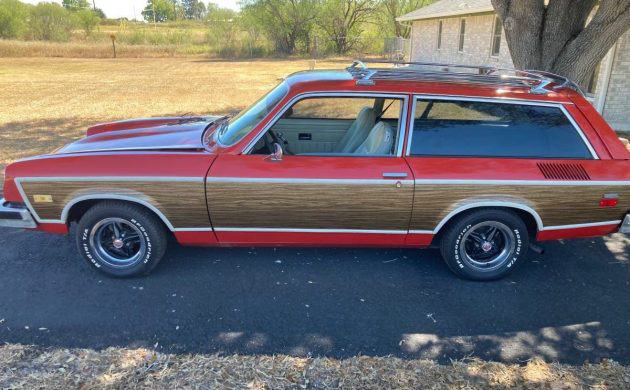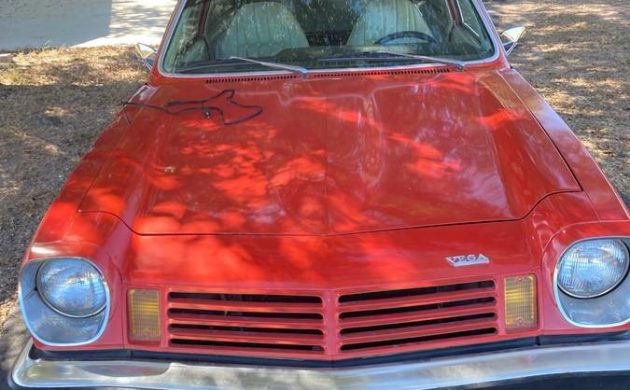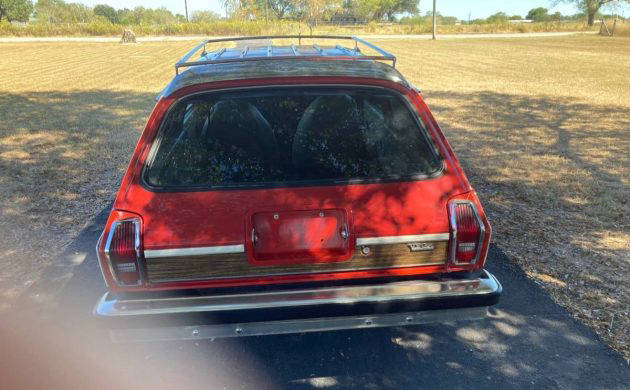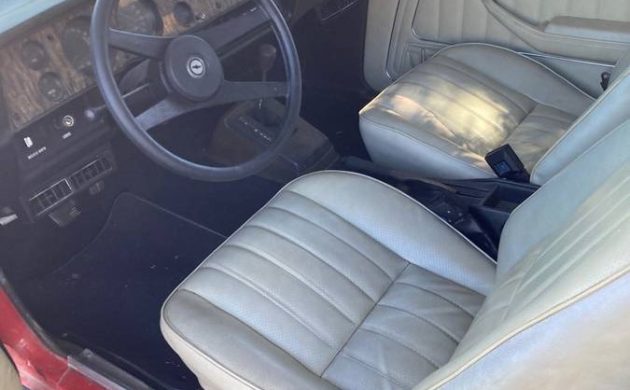Chevrolet built more than two million copies of its subcompact Vega between 1971 and 1977. And yet you see so few of them on the road today because of some infamous quality control issues. But if you were to search out a “rare” Vega, next to the Cosworth Vega the Estate Wagon may be it. The Estate Wagon had nicer trim than a regular entry – and imitation woodgrain paneling. This 1974 edition looks to have held up well and has 74,000 miles to its credit. Located in Victoria, Texas, this not-so-vintage “Woodie” is available here on craigslist for $11,000.
Vegas sales got a huge bump in 1974 thanks to the OPEC oil embargo which promoted buyers to flock to more fuel-efficient forms of transportation. Out of a record 460,000 Vega’s built that year, 115,000 were the Kammback, Chevy-speak for a small station wagon. We don’t know how many of them came as Estate Wagons, but most of the photos I’ve seen of Kammbacks have them without the fake wood pieces on the sides and hatch. We assume that Chevy had worked out the premature rust problems the Vega had early on, as well as the aluminum inline-4 that would sometimes overheat and go bad.
This ’74 Vega has somehow managed to escape the clutches of the Grim Reaper, probably because its owners did more than just drive it until it fell apart. Besides the 4-banger, this one has an automatic transmission, an aluminum radiator, and a Petronix distributor, yet there are no photos to show this stuff off. It’s a well-equipped wagon with power steering and brakes, tilt steering, and air conditioning. There seems to be no rust and the orange-ish paint is at least okay, though a wax job might perk it up.
The interior seems to be in great condition, augmented by a new carpet set. This could be a fun little car to tool around in and might get more than a second look at Cars & Coffee. The asking price is OBO and the seller is willing to take a golf cart in trade (partial) assuming that it’s in good shape. When Chevrolet was peddling these econoboxes, the slogan was “The Little Car That Does Everything Well.” Come see for yourself if that’s true after 50 years. Thanks for the tip, Tony Primo!






This is as cute as a Vega can get! But, maybe sneak a small block in the engine bay with a tranny to handle it, and tweak the suspension and brakes. You would have a sweet little sleeper Vega to tool around in on Saturday night!
Another person who has to tear apart a nice car and put a “hot” engine in it. Sigh. It’s no wonder nice originals are so rare.
LOL I’ve only ever seen these Kammbacks as drag cars.
That’s because they were absolute turds with the stock drivetrain.
Had one, a GT, not the Estate. 4 cyl/4 speed. Paid 250 for it, got t-Boned in it. Got 1000 from the other guys insurance co. It was rusted to death. I’m the only guy I know who made money on a Vega (except the dealer). I’d never pay 11K for one, but someone might
Enjoyed my well optioned 74 Vega GT hatch for many years and the car stayed in the family until 1990. Uncoating the body was one reason it lived so long and the good care it received from me. It sat inside a garage for a few years keeping it from nasty Canadian winters which also helped preserve it.
The Ziebart™️ treatment 🍁
stored in a plastic bubble filled with nitrogen, they didn’t rest much at all.
It isn’t the Winter weather that’s nasty in Canada, it’s what they put on the roads there.
A big second from Minnesota! Remember the 35W bridge collapse?
The Aspen is a way better choice.
A Yugo with flood damage is a better choice
by 1974, the cooling system had been improved. The body was still made of rusty scrap metal.
IIRC tilt wheel was first available for ’75 on H & H specials.
One too many zeros in the price, based on my experience with one. Good luck with the ad!
The writer completely misses the point about the Vega.
The issue was not “quality control.” Not in anyway
The issue was in management entirely. It was a poorly executed program and cost-cutting at the management level guaranteed failure of basically every system in the car.
if it had been put together by the people that assembled Rolexes, or monkeys with diarrhea, you would’ve had the same result.
this was an entirely management caused problem, a catastrophe that happened in the boardroom, not in the assembly line
As the owner of ‘75 Cossie myself, this Kammback is indeed a cool ride. Most issues were worked out with the Vega by ‘74 (except for the rust). If you were religious about oil changes with the pre-‘76 non-Durabuilt engines, they ran a long time.
mine blew a head gasket at 11,000 to 15,000 miles. It could not drive more than 40 mph by the time I dumped it in 1978.
It’s oil was changed religiously. Candles and everything.
The problem was not oil changes,
it was the inherently bad cooling system that could not maintain the narrow range of operating temperatures required for the nikasil alloy block
The cooling issues were twofold. Early models had small undersized radiators and no overflow. The core issue though as was mentioned above was related to using a cast iron head in the aluminum block. This was a cost cutting decision thanks to the brilliant minds that worked directly for Ed Cole at the time. John Delorean had developed an aluminum head with cross flow to address this. It was shot down by Cole and his team. The improvements to the cooling system eventually addressed the heat stress that was ultimately caused by poor heat sinking of the cast iron head.
Pre-Durabuilt engines still had poor crankcase ventilation and therefore were known to dry out valve seals. This is why oil changes were extremely important.
As for the Cosworth, that used an aluminum head from the start. This was not prone to either the overheating issues or the poor ventilation issues. These engines ran for 500 hours at full load during development tests and did not fail. GM only requires 200 hours for such tests.
I decided to do a top end rebuild on mine at 94k, not because it needed it, but rather because I was able to get a full valve set and decided to just do it while I could get it. As for those that say the non-sleeved cylinders are prone to wear I can tell you first hand that is nonsense. When I opened mine up it the cylinders were perfectly smooth. One of the cleanest engines I have seen inside, in fact. Issues with the silicon wearing out in the cylinders is entirely attributed to the early cars with poor cooling.
another cool woodie. we had the monza wagon in 79. great car. wish i had it now